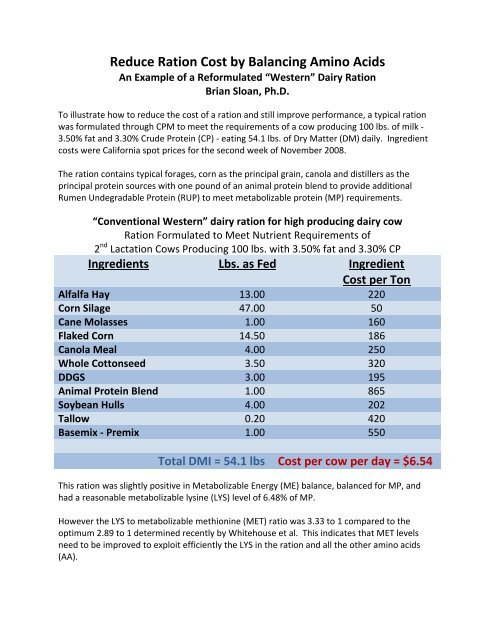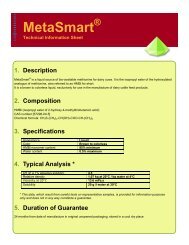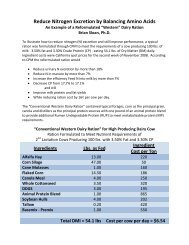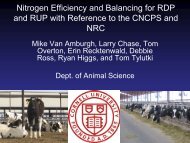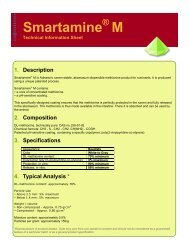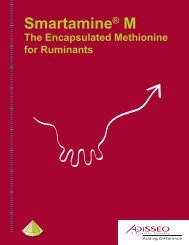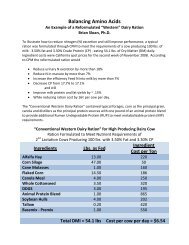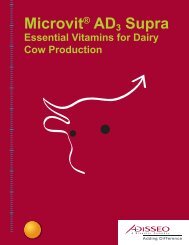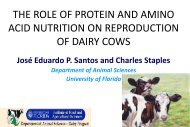Reduce Ration Cost by Balancing Amino Acids - Adisseo.biz
Reduce Ration Cost by Balancing Amino Acids - Adisseo.biz
Reduce Ration Cost by Balancing Amino Acids - Adisseo.biz
You also want an ePaper? Increase the reach of your titles
YUMPU automatically turns print PDFs into web optimized ePapers that Google loves.
<strong>Reduce</strong> <strong>Ration</strong> <strong>Cost</strong> <strong>by</strong> <strong>Balancing</strong> <strong>Amino</strong> <strong>Acids</strong>An Example of a Reformulated “Western” Dairy <strong>Ration</strong>Brian Sloan, Ph.D.To illustrate how to reduce the cost of a ration and still improve performance, a typical rationwas formulated through CPM to meet the requirements of a cow producing 100 lbs. of milk ‐3.50% fat and 3.30% Crude Protein (CP) ‐ eating 54.1 lbs. of Dry Matter (DM) daily. Ingredientcosts were California spot prices for the second week of November 2008.The ration contains typical forages, corn as the principal grain, canola and distillers as theprincipal protein sources with one pound of an animal protein blend to provide additionalRumen Undegradable Protein (RUP) to meet metabolizable protein (MP) requirements.“Conventional Western” dairy ration for high producing dairy cow<strong>Ration</strong> Formulated to Meet Nutrient Requirements of2 nd Lactation Cows Producing 100 lbs. with 3.50% fat and 3.30% CPIngredients Lbs. as Fed Ingredient<strong>Cost</strong> per TonAlfalfa Hay 13.00 220Corn Silage 47.00 50Cane Molasses 1.00 160Flaked Corn 14.50 186Canola Meal 4.00 250Whole Cottonseed 3.50 320DDGS 3.00 195Animal Protein Blend 1.00 865Soybean Hulls 4.00 202Tallow 0.20 420Basemix ‐ Premix 1.00 550Total DMI = 54.1 lbs <strong>Cost</strong> per cow per day = $6.54This ration was slightly positive in Metabolizable Energy (ME) balance, balanced for MP, andhad a reasonable metabolizable lysine (LYS) level of 6.48% of MP.However the LYS to metabolizable methionine (MET) ratio was 3.33 to 1 compared to theoptimum 2.89 to 1 determined recently <strong>by</strong> Whitehouse et al. This indicates that MET levelsneed to be improved to exploit efficiently the LYS in the ration and all the other amino acids(AA).
Conventional Dairy <strong>Ration</strong> for High Producing Dairy CowsNutrient Balance Evaluated <strong>by</strong> CPM Version 3.0.8ME Balance (mcal) 3.00MP Balance (g) ‐7.20LYS (% of MP) 6.48LYS (g) 193.60MET (% of MP) 1.95MET (g) 58.20LYS:MET Ratio 3.33CP % 17.70<strong>Amino</strong> Acid <strong>Balancing</strong> Leads to Better <strong>Ration</strong>s – Lower <strong>Cost</strong>In the reformulated ration example, it was assumed that <strong>by</strong> bringing the ration into balance toachieve a LYS to MET ratio (2.89 to 1) while still maintaining the same level of LYS as a % of MP,the lactation protein efficiency would improve <strong>by</strong> 2.5 points from 0.65 to 0.675. This is ascenario where targeting higher LYS and MET as a % of MP, may not be financially justified dueto the minimal milk protein premium being paid. The ration was reformulated and an aminoacid balanced ration was achieved at a savings of 16 cents per cow per day.The major changes were that the % of forage in the ration increased from 47.6% to 49%, wholecottonseed dropped from 3.50 lbs. to 2.5 lbs. and the inclusion of soybean hulls increased from4 to just over 5.5 lbs.The animal protein blend dropped out of the ration in preference for protected soybean meal.Liquid MetaSmart was formulated in to supply the extra MET needed to bring the ration intobalance.
<strong>Amino</strong> Acid <strong>Balancing</strong> Leads to Better <strong>Ration</strong> – Lower <strong>Cost</strong><strong>Ration</strong> Formulated to Meet Nutrient Requirements of2 nd Lactation Cows Producing 100 lbs. with 3.50% fat and 3.30% CPIngredients Conventional <strong>Amino</strong> Acid Balanced(lbs. as Fed)Alfalfa Hay 13.00 13.50Corn Silage 47.00 48.00Cane Molasses 1.00 1.00Flaked Corn 14.50 13.50Canola Meal 4.00 4.00Whole Cottonseed 3.50 2.00DDGS 3.00 3.00Animal Protein Blend 1.00 1.00/ Protein SBMSoybean Hulls 4.00 5.65Tallow 0.20 0.20Basemix ‐ Premix 1.00 1.00Liquid MetaSmart® 0.05<strong>Cost</strong> per cow per day $6.54 $6.38Not only was the amino acid balanced ration less expensive than the conventional ration, it alsohad a better nutrient profile. MP balance is still close to zero when the 2.5% pointimprovement in MP utilization (lactation protein efficiency) is taken into consideration. Thisallows a savings of over 70 g in MP supply, as you need less MP to meet amino acidrequirements when the MP has an improved amino acid balance.The LYS to MET ratio is improved to meet the target ratio of 2.89 / 1.0. The lysine supply wasdecreased slightly but this has no negative consequence as LYS was in excess in theconventional ration and could not be fully exploited because of the deficit in MET.The CP content of the amino acid balanced ration could be decreased <strong>by</strong> over half a point ofprotein because of the need for less MP supply. What stands out, however, is that the aminoacid balanced ration will supply 7.5 g more MET. This extra MET will give enhancedperformance at a lower cost.
Nutrient Balance Evaluated <strong>by</strong> CPM Version 3.0.8Conventional <strong>Amino</strong> Acid Balanced*ME Balance (mcal) 3.00 2.20MP Balance (g) ‐7.20 6.40LYS (% of MP) 6.48 6.53LYS (g) 193.60 191.00MET (% of MP) 1.95 2.25MET (g) 58.20 65.70 +7.50LYS:MET Ratio 3.33 2.91CP % 17.70 17.10 ‐0.60*Assumes a 2.5% point improvement in MP utilizationIt is important to note that when balancing rations for amino acids, we should always bestriving to maximize the microbial protein contribution, first and foremost. In this example,there was actually a small numeric increase in microbial protein supply; therefore, thereduction in MP supply was all in terms of economizing on the level of supplemental RUPneeded.Nutrient Balance Evaluated <strong>by</strong> CPM Version 3.0.8Conventional <strong>Amino</strong> Acid Balanced*Forage % 47.60 49.00 +1.40Crude Protein % 17.70 17.10 ‐0.60Microbial Protein (g) 1584 1610 +26LYS (% of MP) 6.48 6.53LYS (g) 193.60 191.00MET (% of MP) 1.95 2.25MET (g) 58.20 65.70 +7.50LYS:MET ratio 3.33 2.91*Assumes a 2.5% point improvement in MP utilizationIt is important to recognize the benefits of a lower CP package that is betteramino acid balanced…
The ration was formulated for 100 lbs. of milk which would equate to the production level ofthe high producing group. Assuming this was a one group total mixed ration (TMR) and theherd average was 85 lbs. of milk, how will the supply of an extra 7.5 g of MET as part of anamino acid balanced ration impact milk composition?As a rule of thumb, for every one gram of supplementary MET the estimated response shouldbe 7 g of milk protein. In this example, we could thus expect an extra 52.5 g (0.115 lbs.) of milkprotein. If we assume that milk yield will not change, then an increase in milk protein % ofbetween +0.12% to 0.15% should be observed.Increasing MET <strong>by</strong> at least 5 g also shows, on average, an increase of +0.1% points in milk fat.As we used MetaSmart as the supplementary source of MET in this example, we can alsoanticipate a further response in milk fat due to MetaSmart’s contribution to the rumen pool ofHMB, for a total increase of +0.15% in milk fat.Performance Benefits to <strong>Amino</strong> Acid <strong>Balancing</strong>The + 7.5 g of extra metabolizable methionine will give:1) At least the same lbs. of milk (85lbs.)2) An increase in milk protein (~+0.12% to 0.15%)3) An increase in milk fat (~ +0.15%)And still a lower feed cost of 16 cents per cow per day


